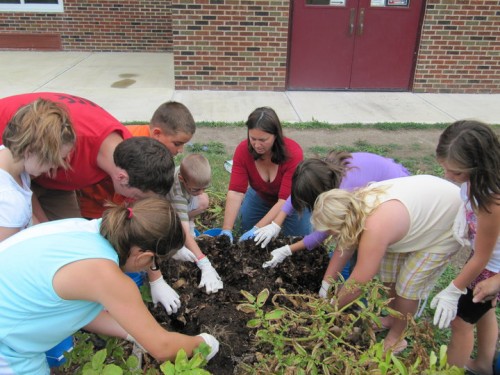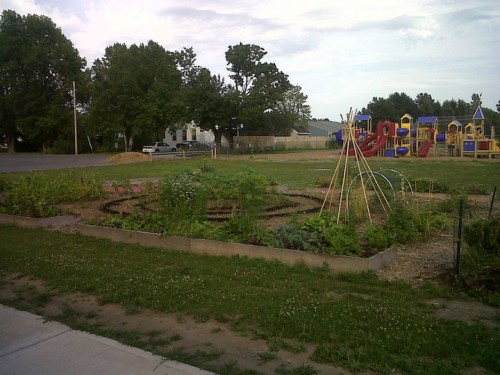Last year, I started a garden at our school in a small town in Northern New York as part of a program out of Cooperative Extension. I was nominated to lead a 4-H group at a meeting I didn’t attend. I consider myself an enthusiastic and somewhat knowledgeable gardener. A leader of small children? I was ill-prepared – and terrified!
With the help of friends, I muddled through and managed to create a delightful garden (in my humble opinion) where at least some of the thirty kids aged 5-10 learned something about gardening they didn’t know before. But it was a struggle, and I sensed there had to be a better way. So when my sister asked me to review How to Grow a School Garden: A Complete Guide for Parents and Teachers

This is a book about how the authors started and grew their school garden at an urban schoolyard in San Francisco. It talks about their experiences, and offers tips and pointers, some of which I found extremely valuable. But one can’t help but get the feeling that these authors have never left their community, or have any connection with the process of starting a garden in, let’s say, rural Northern New York. For example, on the back cover, it touts “Teach in the garden classroom year round”. Most of the school year, our garden is under a giant pile of snow that the plow dumps on it, which the kids love more than any other piece of playground equipment.
The authors devote a lot of time to discussing fundraising strategies and garnering support. The garden design discussed in the book seemed incredibly elaborate, and probably did need a lot of money to build. They also paid someone to serve as a garden coordinator, and suggested hiring a landscape architect. I think more time could have been devoted to a different scenario of school garden, one built by a few volunteers and a few families and businesses donating time and materials. We built a 32′ x 52′ garden with a periphery of raised beds for about $300, with donated leaves, rotten pumpkins, manure, dirt, wood chips, etc., and we raised money for seeds by selling seeds as a fundraiser. Pretty simple.
I located most of my design ideas on the internet, and from books on children’s gardens from the library. Yet I found the design section of this book oddly lacking in — designs! Maybe they thought that was for a different book, or if they put in enough links in the back of the book, you could figure something out. In fact, they don’t talk much about the specifics of actual gardening. I think they assume a certain level of knowledge. They do talk about design, and offer a few caveats and must haves, but it almost feels as though they are talking around it.
As any gardener knows, starting a garden is easy compared to the aftermath of maintaining it. This is where I feel this book really shines – focusing on how you plan a garden to keep it going! While we chose the route in our garden to “build it and they will come” we all know how fast a garden can become a weedy, neglected eyesore. The authors emphasize that the garden needs to be used by many different groups, the more the better. If there is only one group or person involved in the garden, the single group can easily dissolve and no one is left using the garden. They give strategies for getting teachers on board (start with one class, and build on their success), with tips on finding curriculum that fits in with their teaching standard requirements. And my favorite part was the tips on managing classes of kids in the garden. I really wish I had known a few of their pointers last spring, like having one area just for digging, and making rainmakers for kids to water with, for example.
Although sometimes I felt like the authors were gardening on another planet, overall there is much to recommend this book. Use it as one resource as you begin your journey towards growing your own school garden – it is far from a “complete guide” as the title suggests, but has invaluable tips and information that I wish I had had before I broke ground in our garden.







I’ll definitely check this book out.
Here (Ithaca,NY area) we have quite a few school gardens. The school my children go to began theirs last year but it’s very small and it’s nowhere near what was discussed in the planning stages . With all the excellent models right in our area , I’m not quite sure why it isn’t going as well as I think it should be. I do know that when there was a planning meeting, I was one of only a handful of parents who attended so certainly, the school community involvement issue is a huge piece.
I do know that when school garden food is served in the cafeteria, my kids are thrilled and always mention it.
Dear Rosemarie,
Thank you for posting our book on your site. We have a few respectful rebuttals:
While it’s true that we don’t have snowy winters here in San Francisco, I grew up on a farm in rural Maine and did a lot of talking with school gardeners there for this book. Our book is less about the actual gardening and more about cultivating the community around these projects. This aspect of school gardening is, we believe, the most complex piece of the puzzle. Each region will find the best way to use their garden in relation to the seasons. We did, however, suggest a few activities for snowy climates, which came from some teachers in Maine. We also included planting schedules for both rainy and snowy winters. (I also included a small section that touches upon the extension of the seasons, as Eliot Coleman does in his “Winter Harvest Handbook,” for those schools like yours.) We did not include an exhaustive list of activities for each region around the US as this would have made the book a curriculum, which was not our goal.
With regards to design, we are not garden designers. But, we have experienced over 80 original school gardens here in SF, each one sprang organically from the community and look very different from one another. For this reason, we just included the larger issues for communities to be mindful of: non-negotiables like sun exposure, water availability, and the need for good soil. We also mentioned the need for certain types of infrastructure like pathways, sheds, tables, raised beds, etc. For the most “complete” book on schoolyard design, please see our colleague Sharon Danks’ new book: Asphalt to Ecosystems, Design Ideas for Schoolyard Transformation, from New Village Press.
California probably does seem like another planet compared to the cold, wintery northeast (I know it well), however, there are many universal issues that gardens face. We’ve discovered this in all our collaborations with groups from TX, MA, ME, MI, LA, DC, etc. These universal issues are what we tried to highlight in our book.
Thank you!
Rachel
I started a gardening program at a homeless shelter in N. Philadelphia and ran it for a couple of years before the shelter closed. I found that it was really easy to get businesses from the suburbs to donate time, materials, professional designs, and anything else we needed. People were thrilled with this type of outreach, and the kids loved it too. Carolyn
Great review. I like that the aftermath is discussed, too often the maintenance is forgotten.